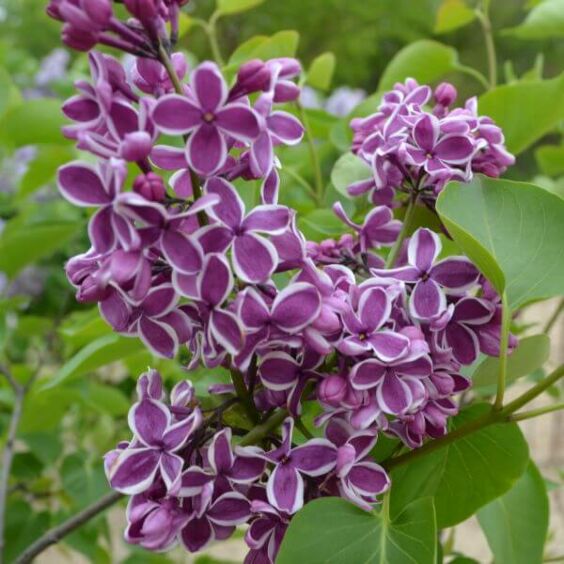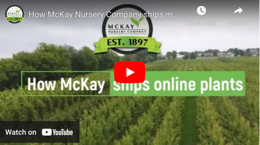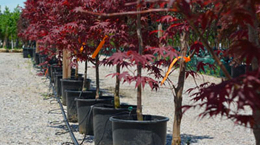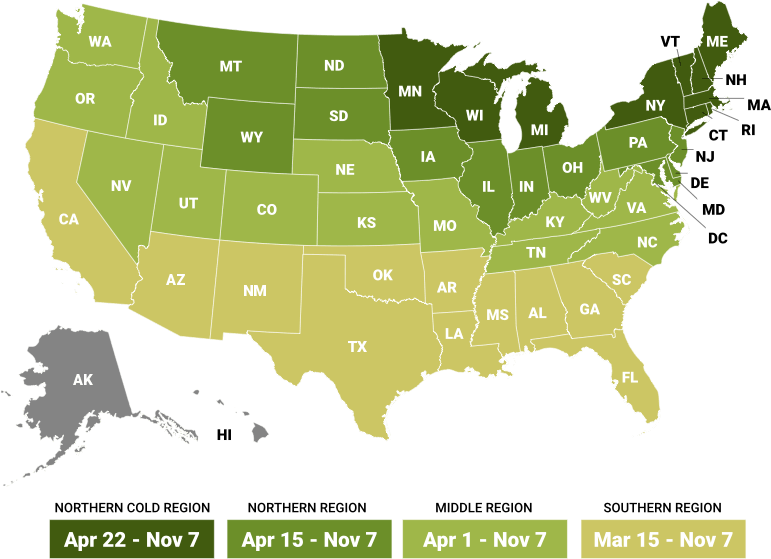
Growing zones
See Zone Map >Status: In stock
- Sun
Mature Plant Size (H x W): 8-10' x 8-10'
Bloom Season: Spring
- Attracts Bees
- Deer Resistant
- Salt Tolerant
- Stone Mulch
- Attracts Butterflies
- Cut Flower
- Fragrant Flowers
- Attracts Pollinators
Planting & Care for Deciduous Shrub – Lilacs
Preparation
- Lilac flowers best in full sun but tolerates light shade.
- Choose an open site, protected from strong, drying winds, where air circulates freely, to reduce risk of leaves becoming mildewed.
- These shrubs need well-drained, organically rich soil.
- Avoid chalky spots, which may cause lime-induced chlorosis, when leaves turn creamy yellow and die.
- Plant Lilacs from March-November
Opening Plant Material
- Bare Root - Cut open the bundle (top and roots are tied) and separate all the plants. Soak roots in buckets of water until planted. Each plant type will be labeled separately for identification. Do not expose the roots to sun. They should never dry out. Keep roots covered. All bare-root plants must be trimmed when planted.
- Grow Bags - Remove bag by using a utility knife to slit up the side and peel off the fabric exposing the soil and roots. Plant the root ball just like you would a container plant. No trimming of roots is necessary for grow bags.
- B&B - Soak root ball very well. Dig a hole at least 6" wider and no deeper than the size of the ball on the plant. Rotate the plant to the proper position. Never lift or move trees by the tops.
- Containers - Fully saturate all container plants by placing them in a larger container of water until the bubbling stops, then remove them. They are now ready for planting. Dig a hole no deeper than the depth of the container and 6" or more, making sure it’s wider on the sides.
Planting Bare Root
- Plant Bare root in fall. A reliable indicator that you can still plant is if the ground remains workable; if so, you're good to go. If a hard frost is expected be sure to hold off on planting.
- Dig a hole at least 6" wider and the same depth as the root mass. The crown or graft of the plant should be slightly higher than ground level where it was grown at the nursery.
- Trim off the broken roots and branches.
- Place fertilizer packets in the hole (if purchased). Do not place other fertilizers in the planting hole. *Use Our Recommended Fertilizer.
- Spread the roots out and fill the hole halfway with soil, then water thoroughly until the soil settles, completely saturating both the soil and the planting pit.
- Re-adjust the plant and fill the hole with the rest of the soil.
- Back fill the balance of the soil and water well.
- Download our “Handling & Planting Guidelines” below for illustrations on planting.
Planting Grow Bags
- Plant grow bags in spring or fall.
- Notice where the base of the trunk flairs out from the tree. This is called the root flair. This root flair should show when the tree is planted. If necessary, add soil under the ball so the root flair is exposed.
- Place fertilizer packets into the bottom of the hole (if purchased). *Use Our Recommended Fertilizer.
- Backfill the hole with soil, making sure the top of the root ball is visible and slightly higher than the soil around it.
- Firm the soil around the plant. Water well to settle the soil around the root ball.
Planting B&B Trees
- Plant B&B trees in spring or fall. A reliable indicator that you can still plant is if the ground remains workable; if so, you're good to go. If a hard frost is expected be sure to hold off on planting.
- Notice where the base of the trunk flairs out from the tree. This is called the root flair. This root flair should show when the tree is planted. If necessary, add soil under the ball so the root flair is exposed.
- Place fertilizer packets into the bottom of the hole (if purchased). *Use Our Recommended Fertilizer
- Backfill ½ of the hole with soil and completely saturate the soil with water.
- Once the tree is straight and located as desired, cut and remove twine. Then, remove or bend back top ? of metal basket. Lastly, remove exposed burlap from top of ball
- Fill the hole to the top of the ball with soil, then soak well with water and let it settle.
- The top of the root ball should be visible and slightly higher than the soil around it.
- Add mulch on top of the soil, making sure not to put mulch against the trunk or stems.
- Download our “Handling & Planting Guidelines” below for illustrations on planting.
Planting Containers
- Slide the plant from the pot by tapping on the bottom of the pot.
- With a shovel or knife, trim bottom 2" off of the root ball for plants in plastic containers.
- Rotate the plant to the proper position. Never lift or move plants by the tops.
- Place the root ball in the hole.
- Notice where the base of the trunk flairs out from the tree. This is called the root flair. This root flair should show when the tree is planted. If necessary, add soil under the ball so the root flair is exposed.
- Place fertilizer packets into the bottom of the hole (if purchased). *Use Our Recommended Fertilizer.
- Backfill the hole with soil, making sure the top of the root ball is visible and slightly higher than the soil around it.
- Firm the soil around the plant. Water well to settle the soil around the root ball.
Pruning - After Planting
- Bare Root - Prune ALL bare root plants to reduce transplant shock and ensure success. Pruning should take place either before planting or as soon as possible afterward. All pruning should be done with a sharp pruning shears.
- B&B & Grow Bags, containers - While it is not crucial for balled and burlapped (B&B), grow bags, or container plants to be pruned immediately after planting, a light pruning to shape, remove any branches damaged during shipping, or thin out a densely branched plant can aid in the transplanting process and improve the appearance of your new planting.
Pruning - Throughout the Season
- Prune in November & December – Cut out spent flower heads when petals fade. Keep bushes youthful and blooming freely by pruning out a quarter of the older shoots each year in winter. Remove basal suckers.
Watering - After Planting
- Plants typically take approximately 6 weeks to establish new roots in your soil. During this period, water plants as often as every 2-4 days at the start and at least a minimum of once per week.
- Beyond the 6 week establishment period, water once per week, unless rains occur.
- Stick your finger into the soil around 3” to check soil moisture.
Watering - Throughout the Season
- After the first season, plants should only be watered during extended periods without rain.
- How do you know if your plants need water? The easiest way to tell is to touch the soil around the roots. If it is moist, there is no need to water. If it is dry, give it a good soaking with the hose end (no nozzle) watering the soil only and not the leaves.
- Stick your finger into the soil around 3” to check soil moisture.
Frequently Asked Questions
Discover helpful gardening tips and insights in our FAQs, featuring McKay Nursery's Sensation Lilac plant.
1. What is the best location to plant a Sensation Lilac for optimal growth?
The Syringa Vulgaris “Sensation” thrives in a location that receives full sun for at least 6-8 hours per day. This ensures vigorous growth and abundant blooms. A site that is open and protected from strong winds, with good air circulation, is ideal to reduce the risk of powdery mildew.
2. When is the ideal time for Sensation Lilac to be fall planted?
The Syringa Vulgaris “Sensation” can be planted in both spring and fall. Fall planted lilacs benefit from cooler temperatures, allowing them to establish roots without the stress of summer heat, leading to a stronger start in the following spring season.
3. What are the soil requirements for a Sensation Lilac?
The Syringa Vulgaris “Sensation” prefers fertile, humus-rich, alkaline to neutral, dry to medium, well-drained soils. It thrives in chalky soils but dislikes overly wet conditions. Ensuring the right soil conditions is crucial for the health and bloom of your lilac bush.
4. How often should I water my Sensation Lilac?
Watering needs are moderate; it's important to water your Sensation Lilac plant when the top 3 cm of soil has dried out. After planting, water regularly to help establish roots, then adjust to less frequent watering, ensuring the plant does not sit in soggy soil.
5. What are the pruning requirements for Sensation Lilac?
Watering needs are moderate; it's important to water your Sensation Lilac plant when the top 3 cm of soil has dried out. After planting, water regularly to help establish roots, then adjust to less frequent watering, ensuring the plant does not sit in soggy soil.
6. How do I manage spent flower heads on a Sensation Lilac?
Removing spent flower heads promptly after blooming can encourage a tidier appearance and potentially more blooms the following year. This practice, known as deadheading, is beneficial for the Sensation Lilac.
7. Can Sensation Lilac tolerate cold temperatures?
Yes, Sensation Lilac (Syringa Vulgaris) is quite hardy and can tolerate cold temperatures well. It's important to ensure it's well-mulched in fall to protect the root system during winter.
Discover the Beauty of Lilac Flowers with McKay Nursery
With over a century of experience, McKay Nursery is a testament to quality and expertise in the horticultural world. Our plants are nurtured on our extensive acreage in Waterloo, Wisconsin, guaranteeing robust, healthy specimens for your garden. Shop online with confidence, thanks to our comprehensive warranty and superior packaging, designed to bring the nursery's best directly to your door. For guidance or inquiries, reach out to us at [email protected] or 920-478-2121.
Planting & Handling Help
Download our Planting and Handling Guide below to plan for a successful arrival and install of your plants. Be sure to water all plants as soon as they arrive and every day until you’re ready to plant. Keep any bare root bundles in a shady, cool spot with the roots covered at all times.


Learn More
Watch our videos on handling bare root plants, how your order is prepared for shipment and more.


Plant Sizing
What is the difference between Containers, Grow Bags, Bare Root, and Balled & Burlap (B&B)?
Shipping Times


Our FedEx and local shipping times depend on two factors, one is by the region and the second is the type of product being shipped. For example, small fruits are only shipped in spring, but majority of our perennials are shipped from spring until fall. Keep in mind the dates below act as a general guide. Due to unpredictable weather, staffing, inventory and industry demands these timelines can change. Therefore, we cannot guarantee any of these times.
Shipping Dates by Region*
Northern Cold Region: April 22nd - November 7th
Northern Region: April 15th - November 7th
Middle Region: April 1st - November 7th
Southern Region: March 15th - November 7th
Local Delivery (small radius from Waterloo, WI): April 22nd - November 7th
Shipping Dates by Season*
Spring Shipping: Region Start Date (above) - May
Fall Shipping: September - November
Due to unpredictable weather, these times may vary. Some varieties are exceptions due to heat and plant health reasons. Enter your shipping zip code at the top of this page and be sure to check the shipping information on each product before you add it to your cart. If the product is too large or restricted in your state, you will not be able to checkout with that item in your cart.
